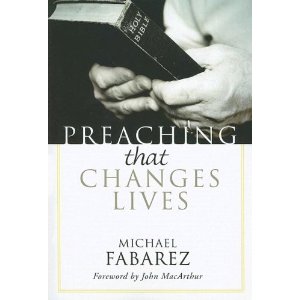
Author: Michael Fabarez
Publisher and Date: Wipf and Stock, 2005 Rank (1-10): 8
*Rank 1-10, with 1 meaning “waste of time” and 10 meaning “must read.”
THESIS OF THE BOOK :
To encourage and empower preachers to preach sermons that not only convey information about the Bible, but that also invoke life-change in their hearers.
GENERAL OUTLINE OF THE BOOK:
Fabarez has broken his book down in to four parts and fifteen chapters. He first calls his readers to rethink the task of preaching. In an age that has emphasized accuracy and information from the pulpit, Fabarez issues a reminder and a warning that information is not enough and that pastors should instead adopt a method that focuses on life-change. The life changing sermon, however, he argues will be built by pastors whose lives have been changed by the gospel and the word of God. He urges pastors to be prepared for the task. The preparation includes creating a sermon, spending time in study, and prayer. Fabarez makes special effort to emphasize the sheer time involved in prayer and preparation and urges pastors to not take shortcuts if they desire for their sermons to make a difference.
In the third section of the book, Fabarez focuses on the act of preaching and some of the mechanics of the preparation process. He encourages pastors to preach sermons that are understandable and to keep Christ at the center of preaching. Only the Life-Changer can bring significant results in the lives of God’s people. In this section, Fabarez also takes time to write to correct a potential error by readers of his book—namely that sermons rich in application must also be doctrinally sound and deep. One must not preach anemic sermons to bring about life-change. He follows this in the final section by focusing on follow through in the church so that sermons can have the greatest impact. The follow through he advocates specifically include small groups that hold each other accountable for applying the sermon, providing tools to help the audience make changes, and personally modeling changes from the previous week’s sermon. The preacher of all people should be changed by the sermon, and the next week’s sermon time presents a great opportunity to model that change before his people.
STRENGTHS OF THE BOOK:
Though this book is overall a pretty good read, it has two strengths that rise to the top above other preaching texts. First, he advocates an outline for preaching that connects the major points of the sermon, not only to the next point in a logical sequence that leads ultimately to a culmination that answers the big question, but instead an outline that connects each preaching point to the next preaching point and to the primary preaching point (think Fallen Condtion Focus, The Big Idea, etc…). A picture of his diagram is beneficial here and can be found at the bottom of this page in the quotes section.
The second major strength of this book is found in the final section where Fabarez links tools that he offers to his congregation to apply the sermons they hear with the small group ministry of their church. The outline sheet that is given out at his church offers a place for note-taking on the front side and offers application questions on the back side which are then used in the church’s small groups ministry (a sample of his worksheet can be found in the book on pages 177 and 182). This offers application opportunities unlike others that I have seen. This, in fact, is a method that we will be experimenting with at my church in the fall of 2011.
WEAKNESSES OF THE BOOK:
The first couple of chapters offered nothing new for anyone who has spent time in preaching literature. In fact, I felt that the first four chapters were especially weak. Literature on the preacher’s personal life and on expository preaching is voluminous and much of it is better than what Fabarez has to offer on the same kinds of subjects covered in the first four chapters. Chapter three, for instance, focuses on the life of the preacher. Unfortuantely, Fabarez seeks to cover so much material in this chapter that it is choppy and difficult to read. His information is solid, but an entire book could easily have been written just on the information he covered in this chapter.
SIGNIFICANT QUOTES FROM THE BOOK:
– “We must purpose to evaluate every sermon we preach in light of the biblical change it brings about in the lives of our congregants” (10)!
– “The preacher does not use the Bible to preach his own message; instead, it is the Bible that uses the preacher to preach its message” (16).
– “The critical distinction, so often missed in one’s study, lies between the “meaning” of a text and its “significance.” Meaning is discovered as I rightly understand eh truth presented in a passage of Scripture; significance is discovered as I rightly determine the impact that truth is intended to make on my congregation” (38).
– “Prayer must be the ‘evident and controlling force’ in preaching because the goal of preaching is supernatural” (70).

